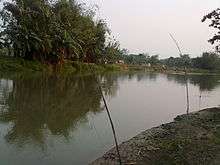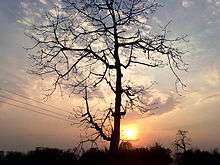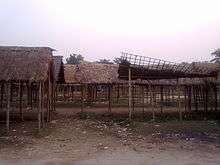Kalaigaon
| Kalaigaon কলাইগাঁও Kālāigaon | |
|---|---|
| Legislative Assembly Constituency | |
|
A view of the rice fields and tree plantations in Kalaigaon | |
 Kalaigaon  Kalaigaon Location in Assam, India | |
| Coordinates: 26°34′29″N 91°58′32″E / 26.57459°N 91.97567°ECoordinates: 26°34′29″N 91°58′32″E / 26.57459°N 91.97567°E | |
| Country |
|
| State | Assam |
| District | Udalguri |
| Government | |
| • Member Of Legislative Assembly | Sri Maheswar Baro (Bodoland People's Front) |
| Area | |
| • Total | 232 km2 (90 sq mi) |
| Elevation | 37 m (121 ft) |
| Population (2011)[1] | |
| • Total | 110,862 |
| • Density | 477/km2 (1,240/sq mi) |
| Languages | |
| • Official | Assamese |
| Time zone | IST (UTC+5:30) |
| PIN | 784525 |
| Telephone code | 91 - (0) 3713 - XX XX XXX |
| ISO 3166 code | IN-AS |
| Vehicle registration | AS-13 & AS-27 (Mangaldai & Udalguri) |


Kalaigaon (Assamese: কলাইগাঁও, Hindi: कलाईगाँव, Kālāigaon) is a town and Legislative Assembly Constituency in north-eastern India. It is situated in the Udalguri district of Assam state. The average altitude is 37 meters. The climate is humid and congenial, while the relative humidity is around 82%. The annual rainfall is around 2,000 mm.
Etymology
The origin of name of this ancient place can be found in a local legend about a brahmin priest, named Kendukalai who was appointed the chief priest of the Kamakhya Temple. According to the legend, he was supposedly able to cause the goddess Kamakhya Devi appear in her mortal form in the temple and dance, because of his musical talents and devotion to her.[2][3] The erstwhile Koch king Naranarayan, coming to know of this, wished to see the goddess. He asked the king to hide near the temple and watch through a hole and began his worship. The goddess appeared and started dancing in the temple, but eventually saw the eyes of the King through the hole, and came to know of his treachery. Some versions of the legends say that the goddess cursed the dynasty of the king and the priest would be destroyed if they ever visited the temple, while others say the angered goddess turned the king into a stone statue and decapitated the priest.[4] The head of the deceased priest got thrown away by the force of the mortal blow and landed in a place 13 km north, which was later named as Muradeor, which was his birthplace.[5] The name of Kendukalai later degraded to Kalaigaon. Even today, Kendukalai village exists 8 km west, towards Tangla, from present day Kalaigaon, on M.B. Road.
Demographics
According to 2011 census records, the total population of Kalaigaon sub-division was 110862, of which, 56285 (50.77%) were males and 54577 (49.22%) were females. Some villages of Kalaigaon fall in Darrang district, and the population there was 24246 (12723 males and 12523 females).[1] The remaining majority of villages are in Udalguri district, and the population there was 85616 (43562 males and 42054 females).[6]
Economy
The economy of this place is heavily dependent on agriculture. Cultivation of rice is the primary agricultural activity, vegetables being a close second.

However, over the last few years, consumerism has contributed to the steep rise in the consumer goods business. Due to heavy rice cultivation, many small indigenous rice mills came up in and around the town which supply rice to other parts of Assam; Guwahati being the largest consumer of its rice. The Kalaigaon rice brand has now set up its own identity in Assam. There are also a number of co-operative societies as well as banking institutes.[7]
This place also has two weekly market days, one on Sundays and another on Thursdays. A unique feature being that livestock trading takes place on Thursdays almost exclusively, which is very rare in these parts of the world. This market is locally known as Goru Bojar, cattle market. These markets attracts a large amount of people around the district every Thursday and Sunday, often making transportation very cumbersome in the town.[8][9][10]
There are also a few tea gardens in and around this town. Before 1950, most of them were owned by British tea companies.[11]
Terrorism and Insurgency
Like other parts of Assam, there has been incidents of terrorism in Kalaigaon.[12] There have been instances when security agencies and terrorists have come into direct conflict within this region. However, in the recent years, the frequency of such incidents have greatly declined.
References
- 1 2 "Kalaigaon of Darrang District". censusindia.gov.in.
- ↑ Kali Prasad Goswami (2000). Devadāsī: Dancing Damsel. APH Publishing. pp. 76–. ISBN 978-81-7648-130-4.
- ↑ "State Formation, Legitimization and Cultural Change A Study of Koch Kingdom" (PDF). The NEHU Journal. 12 (1): 26. June 2014. Retrieved 12 November 2015.
- ↑ "Kamakhya - The Shrine of the Mother Goddess". KamakhyaTourism.com. Retrieved 12 November 2015.
- ↑ Das, Jayanta Kumar. "Rabha Divas observed at Kalaigaon". AssamTimes.org. Retrieved 12 November 2015.
- ↑ "Kalaigaon of Udalguri District". censusindia.gov.in.
- ↑ "The Sentinel". sentinelassam.com. 20 January 2011.
- ↑ Das, Jayanta Kumar. "Weekly villagers' market at Kalaigaon (Sunday)". A S S A M. Retrieved 12 November 2015.
- ↑ "Resource Map of Assam". AssamResources.com. Director of Industries & Commerce. Retrieved 12 November 2015.
- ↑ Animal Husbandry and Veterinary Department, Assam. "Udalguri". ahvassam.in. Animal Husbandry and Veterinary Department, Assam. Retrieved 12 November 2015.
- ↑ Whitby, Paul. "A letter from India". Visiting Assam and Bengal, India. Retrieved 12 November 2015.
- ↑ Ved Prakash (2008). Terrorism in India's North-east: A Gathering Storm. Gyan Publishing House. pp. 464–. ISBN 978-81-7835-661-7.
